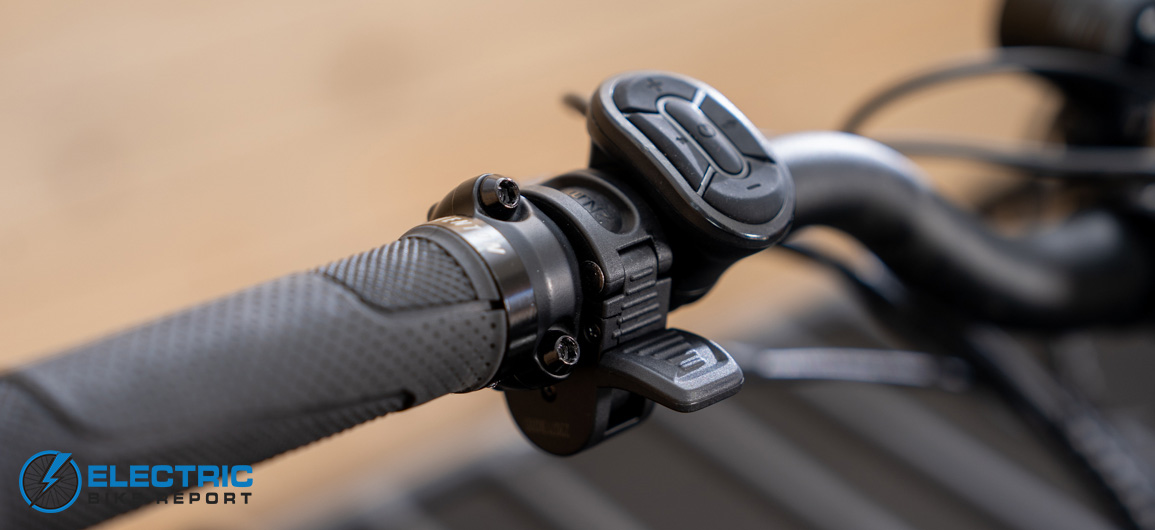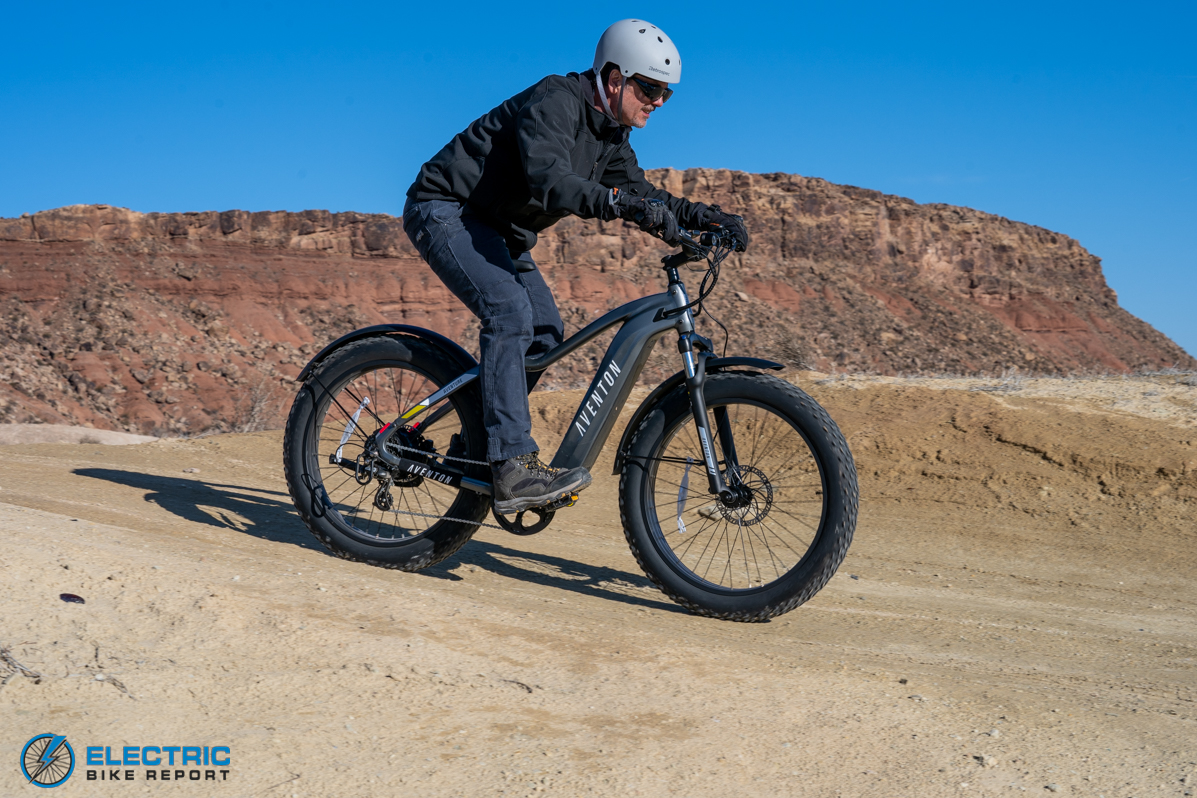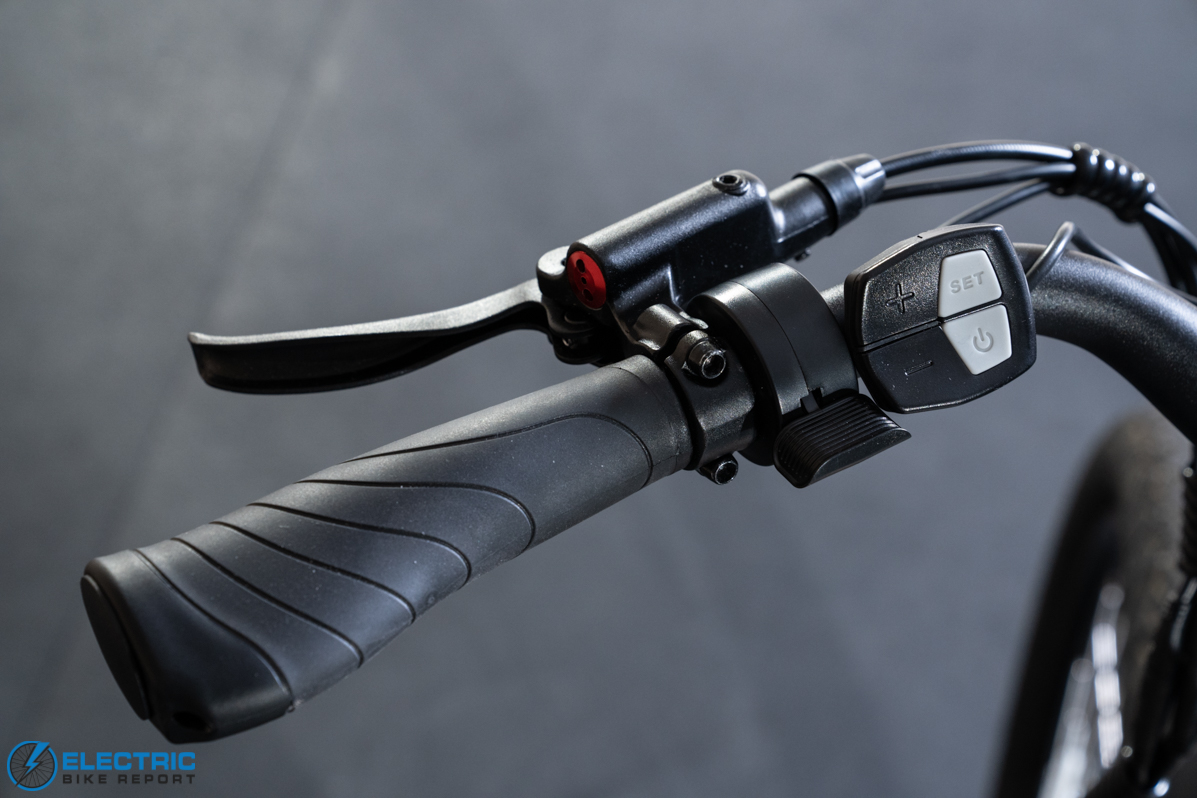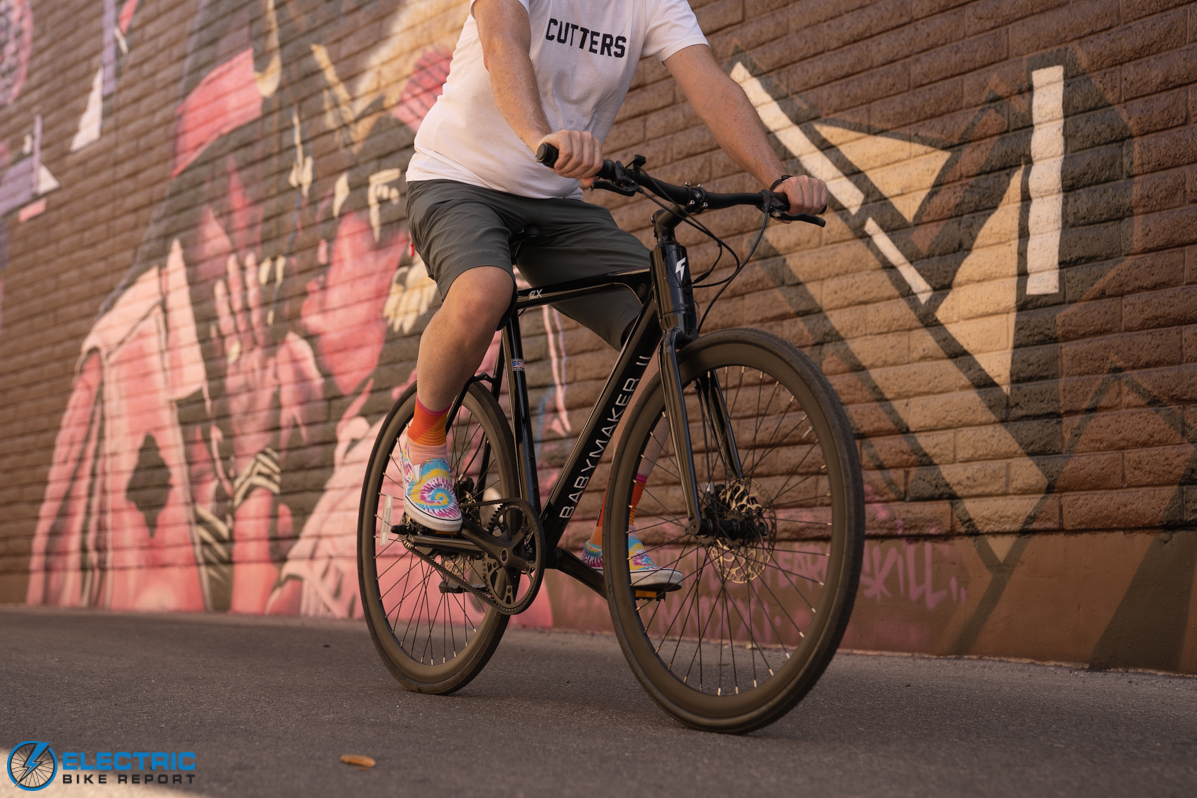Electric Bike Modes: Throttle vs Pedal Assist (Pedelec)
Understanding E-Bike Propulsion Methods and Which is Right for You

Depending on their designation, e-bikes and their motors work in two ways: they can either make your level of pedaling effort easier, or completely take over and simply carry you along for the ride.
When you’re considering which type of e-bike to purchase, it’s important to think about which of these methods the bike offers, the environment(s) you’ll be riding in, and your own abilities and preferences. In this article, the writers here at Electric Bike Report will help you to understand the pros and cons of throttle vs pedal assist electric bikes, and help you to determine which is best for you!
Defining E-Bike Throttle and Pedal Assist Terms
Before we get into the differences between throttle and pedal assist and how they relate to you, let’s define those terms more clearly:
- Throttle: a handlebar-mounted device that can engage (and sometimes adjust) power output from the bike’s motor. Electric bikes with throttles can be completely self-propelled, since throttles tell their motors to dispense power without the need for any pedal motion or input from the rider.
- Pedal Assist: the standard method of operation for e-bikes. As the term suggests, this method of motor engagement requires the bike’s rider to move the pedals, though depending on the bike’s gearing, type of motor, and type of sensor, the rider may or may not need to actually be engaged with the drivetrain.
- Pedelec: This term is a synonym for pedal assist, and is an abbreviation derived from the words “pedal electric cycle.”
It should be noted that, in order to be classified as electric bicycles, all e-bikes must have operable pedals. As such, most e-bikes function through pedal assist, with some having additional throttles – though it is still possible to have a throttle-controlled motor mounted to an otherwise non-electric bicycle with a standard drivetrain.

Many e-bikes, like the Aventon Aventure 2, offer both throttle and pedal assistance for a range of applications in different environments.
E-bike Class System
At least in the US, e-bikes are separated into three classes or categories. This class system plays a significant role in regulating their legal use in specific areas or on specific paths. Their placement within this system is determined by the methods through which they employ their motors, as well as their maximum motor-assisted speeds.
This system, and much of the legislation related to it, exists largely thanks to the incredible, thoughtful, and intelligent folks at People for Bikes. Their work has helped to create a structure for the governance, safety, and consistency of e-bikes, in addition to promoting them as beneficial to the well-being of all. If you can’t tell, we’re big fans!
Let’s take a look at how throttle vs pedal assist ties into this 3-class system.
Class 1
A Class 1 e-bike has a motor that provides assistance only when its rider is pedaling, and is limited to motor-assisted speeds of 20 miles per hour. These e-bikes are capable of going faster than 20 mph, but only on human power beyond that point. These e-bikes do NOT have throttles.
Class 2
Class 2 e-bikes ARE equipped with throttles, and do not require human input to be propelled (though most do also offer pedal assistance). E-bikes in this category are still limited to motor-assisted speeds of 20 miles per hour.
Class 3
Sometimes known as S-Pedelecs or Speed Pedelecs (primarily in Europe), Class 3 e-bikes offer pedal assistance up to a maximum of 28 miles per hour. Additionally, Class 3 e-bikes are required to be equipped with a speedometer. Like Class 1 e-bikes, these can still be pedaled faster than their motor-assisted speeds, but only with human power.
Class 3 e-bikes can ALSO be categorized as Class 2 e-bikes if they feature a throttle that is limited to 20 miles per hour.

Thumb-operated throttle levers, such as this one on the Evelo Omega, are typically the most commonly-used variety.
Unclassified
Any e-bike that differs from the descriptions above falls into the “Unclassified” category. This could be for a number of reasons, such as including a throttle that reaches speeds above 20 miles per hour, or being equipped with a motor with nominal output beyond 750 Watts.
While laws and regulations still vary widely, e-bikes within this category are often only legal off-road or on private property without a license and registration.
Throttle Specifics, Pros, and Cons
As we established, an e-bike throttle is a control mounted on the handlebars that can control the motor. Throttles come in a variety of shapes and sizes, with differing degrees of functionality between them.
Most often, electric bike throttles come in two styles: either twist throttles or throttle levers. Twist throttles usually take up a portion of one of the handlebar grips, and are activated by rotating that portion (usually backward, for safety). Alternatively, throttle levers are a separate unit typically mounted next to one of the grips, and operated by thumb. We have occasionally seen button-style throttles as well, though these are less common.
E-bike throttles can apply their power in a couple of different ways. So-called “modular” throttles are adjustable, and apply more power and speed as they are twisted further, or their levers are depressed more. Others, usually the boost-button-style (but sometimes twist or lever-operated), function more like an on/off switch and apply power in an all-or-nothing fashion.
Additionally, throttles can sometimes be tied in with a bike’s electronic pedal assist system – we’ll cover more about that shortly – to set maximum throttle speeds below 20 miles per hour, if desired. This is a feature that we generally like to see, since keeping a twist throttle turned halfway or a throttle lever partially pushed down for a long period of time can be challenging.
Throttles are typically seen on bikes with rear-hub motors, though they do occasionally appear alongside mid-drives.

Some electric bike throttles come in the form of a twist throttle, like this one on the Lectric XPremium.
 Pros of E-Bike Throttle Use
Pros of E-Bike Throttle Use- Since throttle engagement does not require pedaling, it places no strain on the knees and thighs. This makes electric bikes with throttles great for older folks or anyone with medical conditions that affect pedaling ability.
- For cyclists who frequently find themselves in high-traffic environments, throttles can allow for swift startups that bring the bike up to speed quickly. This means keeping up with traffic more easily, and passing more safely through intersections.
- If used on a Class 2 or 3 e-bike, throttle use allows riders to work less when encountering hills or headwinds, or to simply take a rest when needed.
 Cons of E-Bike Throttle Use
Cons of E-Bike Throttle Use- Because the motor is the only thing powering the bike when the throttle is engaged, prolonged use can drain the battery much faster than when using pedal assist.
- With throttles that are not tied into the bike’s pedal assist system, their speed may be difficult to keep consistent over extended periods of time.
- When used with rear hub motors, throttles have fixed gearing that cannot be adjusted to suit the intensity of the rider’s environment.
Pedal Assist
Whether using an e-bike with a mid-drive motor or a hub motor, the bike’s pedal assist system (or PAS) will govern the amount of assistance the motor provides when pedaling. Generally speaking, this allows for an efficient system that divides the amount of work required to move the bike between the motor and the rider.
Pedal assist electric bikes typically offer multiple stages of assistance; most commonly between 3 and 5. The lowest settings are usually the most efficient and require less power from the battery, but this means that more human power is required to move the bike. Conversely, high PAS settings draw more power from the battery, but also require less pedal power as the motor dispenses a greater amount of assistance.
Depending on the size of the motor, the type of motor, and the PAS setting, using pedal assistance extends the limits of what a person can do on a bike. This can be as little as an additional 15-20% of what a rider is capable of, or it can skyrocket up to beyond 300%. This is what makes e-bikes so much fun!

Class 1 pedal assist electric bikes like the FLX Babymaker II do not include a throttle, and many are able to maintain a traditional non-electric bike feel.
Let’s quickly examine the types of motors, the different sensors they use to know how and when to provide pedal assistance, and how these things impact a bike’s feel.
Motor Types
Hub Motors
As their name suggests, these are motors mounted in the center of either the front or rear wheel. Rear-hub motors are most common, and typically produce a feeling of being pushed from behind, though the intensity of this feeling differs depending on the motor’s size / power level. Due to their positioning, the amount of rider input that is needed with hub motors varies greatly, though this is related to the type of sensor they use – we’ll go over that soon. For those who want to learn more, check out our complete guide to hub motor brands.
Mid-Drive Motors
Mid-drives are placed within a bike’s bottom bracket, and as such are tied directly in with its drivetrain through the cranks. These types of motors typically feature a much more natural ride feel much closer to that of a non-electric bike. They also tend to require a greater degree of rider input, which makes them typically more efficient than hub motors. Again, this depends on many factors, including their sensors. We go into more detail about this type of motor in our complete guide to e-bike mid-drive motors.
Sensor types
Cadence
Cadence sensors, which are mostly found on hub motors, typically use a series of magnets or an optical system to detect pedal motion, and direct the motor to dispense power in tandem with the speed of crank rotation (rotations per minute, or RPMs). The PAS settings on a system with cadence sensors commonly set a “top speed” within each level that can be maintained with or without engagement with the drivetrain. As long as the pedals move, the motor supplies power.
Mid-drive motors with torque sensors, such as this one on the Quietkat Rubicon, commonly offer a much more natural and responsive pedal assist feel than a hub motor with a cadence sensor.
Torque
On the opposite end of the spectrum are torque sensors, which detect how much pressure the rider is applying to the bike’s pedals – essentially, how hard they are working – and tell the motor to supply power to compensate. In these cases, a bike’s PAS settings dictate how much power is dispensed with each pedal stroke. This results in a more natural and responsive pedal assist feel that pairs nicely with the sensation provided by a mid-drive motor, so it is no surprise that torque sensors are commonly used with motors of this type. That said, the technology is becoming more common on hub motors.
 Pros of Pedal Assist
Pros of Pedal Assist- On e-bikes with motors that have well-tuned sensors, using pedal assist feels intuitive and nearly identical to riding a non-electric bike. This makes riding an e-bike an easy and fun skill to learn!
- Using pedal assistance can provide a great workout and all of the health benefits that come with it!
- When compared to throttle use, pedal assist is typically more efficient, meaning that it requires less battery power and can allow a bike to travel farther.
- Considering that most e-bikes have more than a single speed, pedal assist can take advantage of both a bike’s gearing and PAS to adapt its feel to its environment.
 Cons of E-Bike Throttle Use
Cons of E-Bike Throttle Use- Using only pedal assist when starting can be much slower than throttle use, making city rides a bit more difficult.
- Depending on the motor and the type of sensor it uses, the bike’s motor responsiveness can vary greatly.
- Managing a bike’s gearing and PAS setting can take some effort and practice to master.
Where to Go Next
We hope that you have found this article helpful! When you’re considering the differences between a pedal assist electric bike and an electric bike with a throttle, you’re really only scratching the surface of what makes them unique.
If you’re interested in learning more, we recommend taking a look at our Buyer’s Guide to Electric Bikes and learning about these mistakes to avoid when shopping for electric bikes.
Happy researching and riding!



I have a Shimano-assisted ICE Adventure trike with torque-actuated crank motor which works well at only 250W. My objective is exercise and freshly polluted air, so I only use the assist when I have to, say road crossings and hills I can’t handle. When I hit the 3rd assist level (3 clicks of the proverbial button), the boost is more than sufficient, so I don’t need a throttle. The range is supposedly over 100 miles on assist 1, although I have never used more than 2 bars of juice on the usual rides around Ohio or Florida. My only gripe is that the front gearing is not sufficient for me to avoid the assist more. For some reason, the designers eliminated all but one sprocket on the front (I’d like to know why).
My wife (80yr-old) has an aluminum Greenspeed X7 that is light and had 30 gears. I was able to maintain that bike at 12-15 mph for 15 miles without too much stress, but she needed help, so I installed a hubmotor kit (Burley) from Electric Bike Outfitters. Aside from some issues wrt the 16 inch wheels, it works as designed. The problem is that the design could use some help. I had to sacrifice the smallest front sprocket to get the pedal assist magnet disk on the Shimano Hollotech crank set. There is no torque sensor (which I am looking to correct (maybe with Juiced Bike or GRIN parts). The upshot is that I had to program in the lowest limits on current and voltage to tone things down so that there is sufficient pedal power required to get some exercise on assist 1. Assist 2 is sort of marginal, and for all intents and purposes levels 3-5 are just cruise levels. It only takes minimal cadence of 15rpm to get full power out of the motor. On the other hand, the throttle kicks in promptly and my wife can zoom across roads safely, hooting with glee. For someone who has yet to buy, I would recommend looking at GRIN. Buy something with 20-26″ rear wheels and decide whether you want to limit the mechanical gears to 10 and get a crank (mid-drive) motor with torque control. In order to install a torque sensor, either the sensor has to have room and design to be installed on the drive side of the rear wheel (axle strain measurement) or inside (or on) the bottom bracket crank (crank strain measurement). I believe GRIN has an electronics system that can handle pedal rotation and torque signals at the same time, plus provide for throttle. The display (that I have seen) provides a lot on info, but it is only a thing that an engineer could love.
PS. Your heading for the section detailing the cons of pedal assist systems is incorrect – bit of a glaring miss for the editor!!
Almost two years later and the heading has not been corrected!
Do you folks even read the comments?
What’s wrong with the heading?
Why don’t they just put torque sensors on all the bikes, it would be safer. Smoother transaction , cadence gives you a sudden lurch, a cheap unsafe design!
I still loved my old 21spd mountain bike converted to front hub electric drive, throttle only, with a regenerative capacity if you pressed the button, for braking and recharging the battery. It was direct drive, the ECU ran everything from Hill climbing to flat out commuting and it was quick off the mark in traffic, and I had all 21 gears to play with to add to its versatility. Flat out with me pedalling in top cog as hard as I could, 40kmh was possible with a range of about 55km at that speed.
I’ve recently forked out for a road bike (Scott Addict 30) and have had a Pedelec for about 7yrs. It’s a proper pedelec that keeps me pushing hard from start to stop – and I love it. Often strapped for time and I want to go somewhere fast – the pedelec is my preferred choice for that. However, a road bike is something I’m growing into, and will make increasingly more use of it. To get fitter quicker, I need to get off the pedelec and onto the Scott, I’ll be there soon but I suspect it won’t be a straight swap because the pedelec is simply so much fun on and off road.
On our Lectric 2.0XPst bikes I’ve turned off the Pedal Assist, as it can throw me off-balance if turning at low speed. But the twist throttle on Lectrics is great and works just as on a scooter. It doesn’t control motor effort; rather, it controls the set speed. If I hold the throttle for 15mph, for example, then if the road begins to rise and the speed begins to drop below 15mph the motor will increase its torque.
What’s also great about these bikes is that you can easily set the speed in Cruise Control and then you can release the twist throttle.
So, essentially, we regard our bikes as just regular (slightly heavy) 7-speeds that also happen to have a 1 hp motor, controlled by a twist throttle, just as on a scooter.
I can’t believe how hard it is to get basic info on ebikes. Your statement, “These e-bikes are capable of going faster than 20 mph, but only on human power beyond that point.” makes no sense. What does the motor do – turn off at 20 mph, so it is just as you say: “… only on human powerat that point”? So if you’re hovering around 20mph things get jerky with the motor constantly kicking in and out?
It varies from bike to bike, but the better bikes sort of taper off the motor power to avoid that jerky sensation.